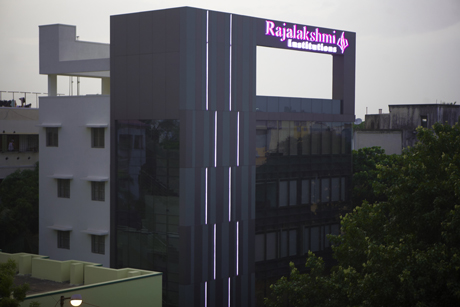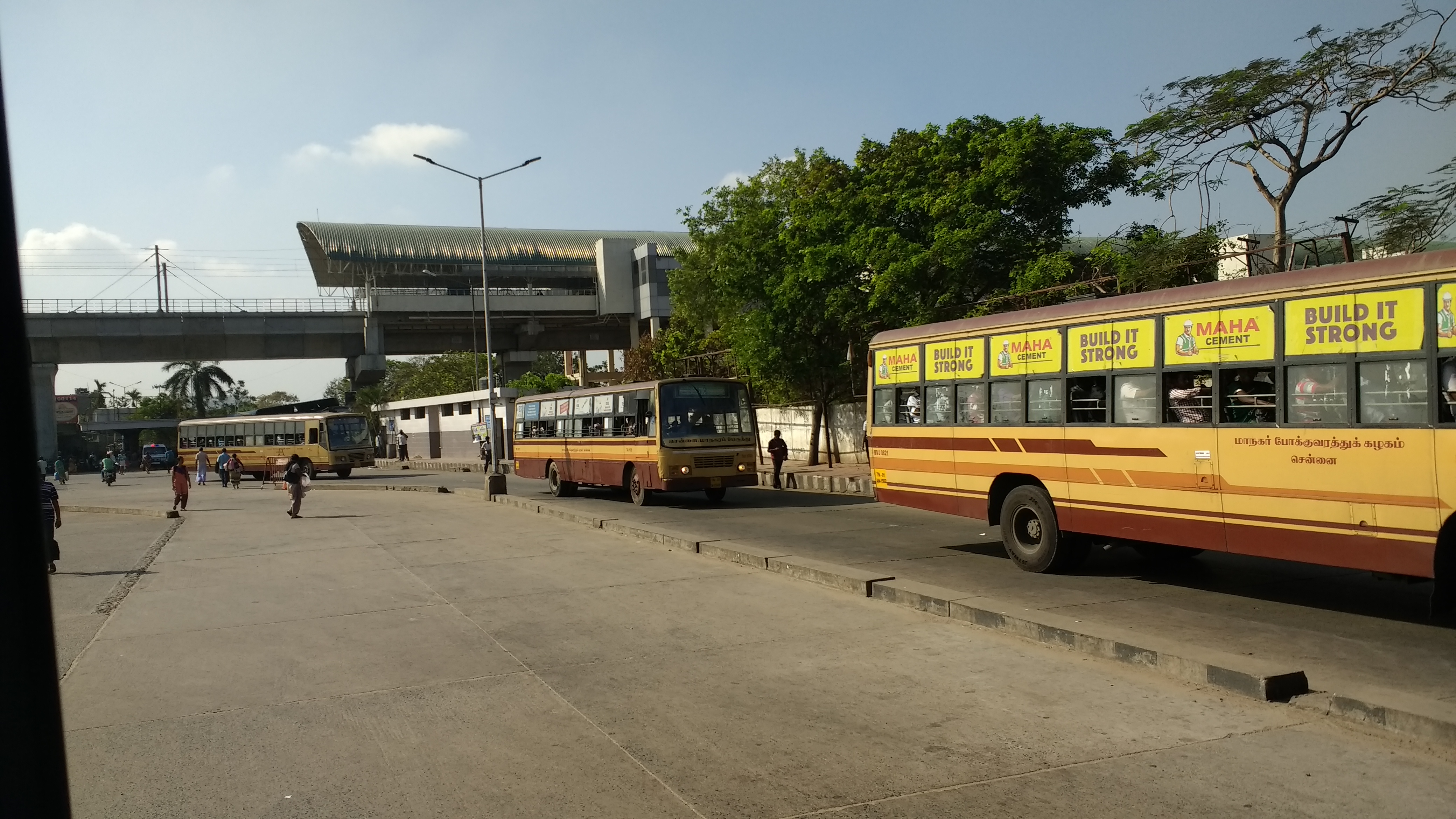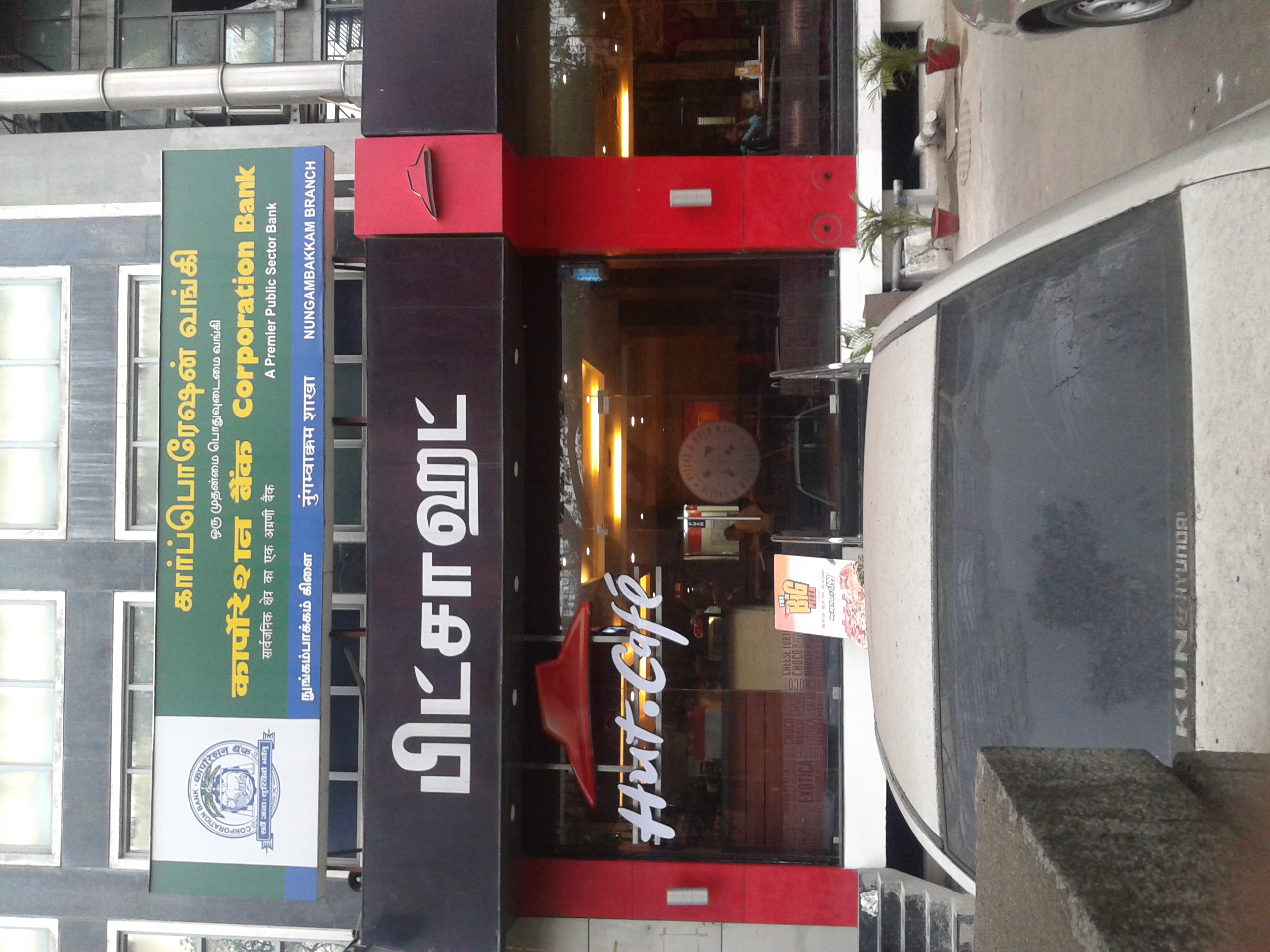|
Chetpet, Chennai
Chetpet is a locality in the Indian city of Chennai It is served by Chetpet railway station in the Beach–Tambaram line of Chennai Suburban Railway. Chetpet has a pond between the Chetpet railway station and the Poonamallee High Road, one of the last surviving natural water bodies in the city. It is the locality in Chennai where the mathematician Ramanujan died. History Along with Egmore and Nungambakkam, Chetpet is considered one of the original villages merged by the British to form Chennai. Development Until recently, the waters of Chetpet lake supplied groundwater recharge for the surrounding neighbourhoods. Location – Chetpet Chetpet is located at the center of Chennai, not far from Egmore railway station. CMBT Chennai Mofussil Bus Terminus (CMBT) (officially Puratchi Thalaivar Dr. M.G.R. Bus Terminus) is a bus terminus located in Chennai, India, providing inter-state bus transport services. It is located on the inner-ring road (Jawaharlal Nehru Ro ... is 8 ... [...More Info...] [...Related Items...] OR: [Wikipedia] [Google] [Baidu] |
States And Territories Of India
India is a federal union comprising 28 states and 8 union territories, with a total of 36 entities. The states and union territories are further subdivided into districts and smaller administrative divisions. History Pre-independence The Indian subcontinent has been ruled by many different ethnic groups throughout its history, each instituting their own policies of administrative division in the region. The British Raj mostly retained the administrative structure of the preceding Mughal Empire. India was divided into provinces (also called Presidencies), directly governed by the British, and princely states, which were nominally controlled by a local prince or raja loyal to the British Empire, which held ''de facto'' sovereignty ( suzerainty) over the princely states. 1947–1950 Between 1947 and 1950 the territories of the princely states were politically integrated into the Indian union. Most were merged into existing provinces; others were organised into ... [...More Info...] [...Related Items...] OR: [Wikipedia] [Google] [Baidu] |
Egmore
Egmore is a neighbourhood of Chennai, India. Situated on the northern banks of the Coovum River, Egmore is an important residential area as well as a commercial and transportation hub. The Egmore Railway Station was the main terminus of the Madras and Southern Mahratta Railway and later, the metre gauge section of the Southern division of the Indian Railways. It continues to be an important railway junction. The Government Museum, Chennai is also situated in Egmore. Other important institutions based in Egmore include the Government Women and Children's Hospital, the Tamil Nadu State Archives and the Tamil Nadu Archaeology Department. The Wesley Church, Egmore is the oldest church of the region. History The earliest references to Egmore occur in the inscriptions of the Chola king Kulothunga I. Under the Chola Empire, Egmore was the headquarters of an administrative division or ''Nadu'' called Elumbur Nadu. An inscription of the Nellore Chola king Vijaya Kanda Gopal dated 2 Se ... [...More Info...] [...Related Items...] OR: [Wikipedia] [Google] [Baidu] |
Aminjikarai
Aminjikarai, originally Amaindakarai, is one of the oldest neighbourhoods in Chennai, Tamil Nadu, India. The arterial Poonamallee High Road ( NH 4) runs through it. Aminjikarai was annexed to Madras District in the year 1946, and Arumbakkam and Anna Nagar were carved out of Aminjikarai in the 1950s and 1970s. The Nelson Manickam Road that traverses through Aminjikarai is an important commercial road in Chennai city. History A delta formed from the deposition of the sediment carried by the river Cooum towards its journey to the Bay of Bengal is called Amainda Karai ''(which means shaped/formed/created banks / land in Tamil)'' and later on Aminjikarai colloquially. According to another version, the name derived from the word ''amanjutal'', which means 'free community service'. Probably, at some stage, the banks of Cooum at this point (at Amanjikarai) should have broken, and the local people should have offered free community service in rebuilding the banks (karai) of the river ... [...More Info...] [...Related Items...] OR: [Wikipedia] [Google] [Baidu] |
Purasaiwalkam
Purasawakkam, also known as Purasaiwakkam or Purasai / Purasawalkam, is a residential shopping area in the district of Chennai in the state of Tamil Nadu, India. It is close to the Chennai Central and Chennai Egmore railway stations. Etymology The name "Purasai" came from the name of a tree called 'purasai maram' in Tamil. In olden days this area was abundant with these trees. Also, there were a lot of stables at once in an age which was referred as (horse) "puravi" in Tamil, puravivakkam later termed as purasaiwakkam. The Gangadeeshwarar temple near the Purasawalkam tank speaks about this history. The tank belongs to this temple. The Gangadeeshwarar temple is very famous temple for ages. Here the Shiva Lingam which is situated at mulasthanam, has a unique feature of wetness throughout the year. Even in the drought conditions and severe summer seasons, the wetness near the Shiva Lingam is observed. Another story is that, in 1799, Company Assistant Surgeon John Underwood of ... [...More Info...] [...Related Items...] OR: [Wikipedia] [Google] [Baidu] |
Kilpauk
Kilpauk is a semi residential area located in Chennai, Tamil Nadu, India. The distance from Chennai's city to Kilpauk is about 6 km. The region is situated off the Poonamallee High Road in the west. Adjacent areas of Kilpauk include Chetpet, Kellys, Egmore, Ayanavaram, Anna Nagar, Choolaimedu and Purasawalkam. The nearest railway station for Kilpauk is the one at Chetpet. This railway station lies to the south of Kilpauk and not more than a kilometre away. There are two metro stations which connects to Kilpauk, they are Nehru Park and Kilpauk (entrance of the Kilpauk Medical College). The Chennai Airport is about 18 km from Kilpauk. This place was a cantonment area for British troops before India's independence. Today this locality is known as "Little Korea" due to the Korean population residing in this area. The neighbourhood has a historical water-treatment plant. On the other end, to the west, is the Institute of Mental Health, one of the oldest mental asyla ... [...More Info...] [...Related Items...] OR: [Wikipedia] [Google] [Baidu] |
Chennai Mofussil Bus Terminus
Chennai Mofussil Bus Terminus (CMBT) (officially Puratchi Thalaivar Dr. M.G.R. Bus Terminus) is a bus terminus located in Chennai, India, providing inter-state bus transport services. It is located on the Inner Ring Road, Chennai, inner-ring road (Jawaharlal Nehru Road) in Koyambedu between SAF Games Village and the Koyambedu Vegetable Market. It is the largest bus terminus in India as well as Asia. Chennai Metro Rail operates a coach depot behind the bus terminus since 2015. History The bus terminus originally functioned at the Broadway bus terminus, Broadway terminus near Madras High Court in George Town, Chennai, George Town, in an area covering about . With the growing population and transportation demand, a new terminus was planned at Koyambedu. The terminus was planned and construction started on 6 June 1999 by M. Karunanidhi during Dravida Munnetra Kazhagam, DMK government at a cost of 103 crores and inaugurated on 18 November 2002 by J. Jayalalithaa during ... [...More Info...] [...Related Items...] OR: [Wikipedia] [Google] [Baidu] |
Chennai Egmore Railway Station
Chennai Egmore, formerly known as Madras Egmore, also known as Chennai Elumbur (station code: MS), is a railway station in Chennai, Tamil Nadu, India. Situated in the neighborhood of Egmore, it is one of the four intercity railway terminals in the city; the other three are Chennai Central railway station, Tambaram railway station and Chennai Beach railway station. The station was built in 1906–1908 as the terminus of the South Indian Railway Company. The building built in Gothic style is one of the prominent landmarks of Chennai. The main entrance to the station is situated on Gandhi-Irwin Road and the rear entrance on Poonamallee High Road. The station was apparently constructed from 8679 on land purchased from Pulney Andy. The building is built in the Gothic style of architecture with imposing domes and corridors. It has the 5th longest platform in the country and the 6th longest in the world. The station is one of the prominent landmarks of the city of Chennai. The recently ... [...More Info...] [...Related Items...] OR: [Wikipedia] [Google] [Baidu] |
The Hindu
''The Hindu'' is an Indian English-language daily newspaper owned by The Hindu Group, headquartered in Chennai, Tamil Nadu. It began as a weekly in 1878 and became a daily in 1889. It is one of the Indian newspapers of record and the second most circulated English-language newspaper in India, after '' The Times of India''. , ''The Hindu'' is published from 21 locations across 11 states of India. ''The Hindu'' has been a family-owned newspaper since 1905, when it was purchased by S. Kasturi Ranga Iyengar from the original founders. It is now jointly owned by Iyengar's descendants, referred to as the "Kasturi family", who serve as the directors of the holding company. The current chairperson of the group is Malini Parthasarathy, a great-granddaughter of Iyengar. Except for a period of about two years, when S. Varadarajan held the editorship of the newspaper, the editorial positions of the paper were always held by members of the family or held under their direction. Histo ... [...More Info...] [...Related Items...] OR: [Wikipedia] [Google] [Baidu] |
Groundwater Recharge
Groundwater recharge or deep drainage or deep percolation is a hydrologic process, where water moves downward from surface water to groundwater. Recharge is the primary method through which water enters an aquifer. This process usually occurs in the vadose zone below plant roots and is often expressed as a flux to the water table surface. Groundwater recharge also encompasses water moving away from the water table farther into the saturated zone. Recharge occurs both naturally (through the water cycle) and through anthropogenic processes (i.e., "artificial groundwater recharge"), where rainwater and or reclaimed water is routed to the subsurface. Processes Water is recharged naturally by rain and snow melt and to a smaller extent by surface water (rivers and lakes). Recharge may be impeded somewhat by human activities including paving, development, or logging. These activities can result in loss of topsoil resulting in reduced water infiltration, enhanced surface runoff and ... [...More Info...] [...Related Items...] OR: [Wikipedia] [Google] [Baidu] |
Chetpet Lake
Chetpet lake (Chethupattu Aeri) is a lake spread over 16 acres in Chetput, Chennai, India. It is located to the north of Chetpet railway station. It is the only existing lake at the centre of the city. The lake belongs to the Department of Fisheries of the Tamil Nadu government. Of the total area of the lake, the waterbody is spread across 9.1 acres and the land area covers 6.9 acres. An anglers club was functioning till the 1940s in the lake, whose members visited the small island in the midst of the waterbody for fishing. Although not used for drinking purposes, the lake was a source of groundwater recharge for the surrounding areas. As the water quality is not saline, the lake has a few varieties of fishes such as rohu, catla and mrigal. Breeding is monitored to assess the water quality. History In 1934, the lake was taken over by the Department of Fisheries to conduct research. In the following decade, a hydro-biological research station was set up to conduct studies in fi ... [...More Info...] [...Related Items...] OR: [Wikipedia] [Google] [Baidu] |
History Of Chennai
History (derived ) is the systematic study and the documentation of the human activity. The time period of event before the invention of writing systems is considered prehistory. "History" is an umbrella term comprising past events as well as the memory, discovery, collection, organization, presentation, and interpretation of these events. Historians seek knowledge of the past using historical sources such as written documents, oral accounts, art and material artifacts, and ecological markers. History is not complete and still has debatable mysteries. History is also an academic discipline which uses narrative to describe, examine, question, and analyze past events, and investigate their patterns of cause and effect. Historians often debate which narrative best explains an event, as well as the significance of different causes and effects. Historians also debate the nature of history as an end in itself, as well as its usefulness to give perspective on the problems of the p ... [...More Info...] [...Related Items...] OR: [Wikipedia] [Google] [Baidu] |
Nungambakkam
Nungambakkam is a locality in downtown Chennai, India. The neighborhood abounds with multi-national commercial establishments, important government offices, foreign consulates, educational institutions, shopping malls, sporting facilities, tourist spots, star hotels, restaurants, and cultural centers. Nungambakkam is also a prime residential area in Chennai. The adjoining regions of Nungambakkam include Egmore, Chetpet, T. Nagar, Kodambakkam and Choolaimedu. History Nungambakkam is one of the oldest parts of Chennai. It formed the western limits of Madras until the 1960s, and it was part of Madras since the 18th century. According to K.V. Raman's ''The Early History of the Madras Region'', Nungambakkam features in an 11th-century copper plate pertaining to Rajendra Chola. According to the Chennai Corporation's records, Nungambakkam village, which was under a Mughal firman, was handed over to the British along with four other villages (Tiruvatiyoor, Kathiwakam, Vyasarpad ... [...More Info...] [...Related Items...] OR: [Wikipedia] [Google] [Baidu] |






.jpg)
